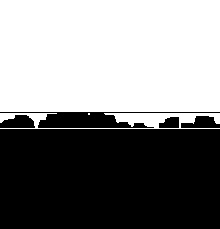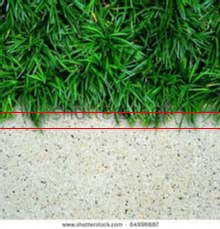This forum is disabled, please visit https://forum.opencv.org
 | 1 | initial version |
You can follow the below step to find the minimum and maximum boundary.
Morphological operation to fill-out the black region. Here you will get binary image with boundary of 0 value.
Scan each column until black pixel to find minimum and maximum boundary.
Here is the code
#include <iostream>
#include <stdio.h>
#include <opencv2/opencv.hpp>
using namespace cv;
using namespace std;
int main( int argc, char** argv )
{
Mat edge,dst,threshold;
Mat HSV;
int dilation_size =4;
Mat src = imread( "src.jpg",1);
blur( src, src, Size(2,2) );
cvtColor(src,HSV,CV_BGR2HSV);
inRange(HSV,Scalar(44,90,30),Scalar(76,255,255),threshold);
Mat element = getStructuringElement( MORPH_RECT,Size( 2*dilation_size + 1, 2*dilation_size+1 ), Point( dilation_size, dilation_size ) );
morphologyEx( threshold, dst, MORPH_CLOSE, element );
int minBound=dst.rows;
int maxBound=0;
int tmp=0;
for(int i = 0; i < dst.cols; i++){
for(int j = 0; j < dst.rows; j++){
if(dst.at<uchar>(j, i)==0){
tmp=j;
break;
}
}
if(tmp<minBound) minBound=tmp;
if(tmp>maxBound) maxBound=tmp;
}
line(dst, Point(0,minBound), Point(dst.cols,minBound), Scalar(0), 1,8, 0); //minmum boudary
line(dst, Point(0,maxBound), Point(dst.cols,maxBound), Scalar(255), 1,8, 0); // maximum boundary
line(src, Point(0,minBound), Point(dst.cols,minBound), Scalar(0,0,255), 1,8, 0); //minmum boudary
line(src, Point(0,maxBound), Point(dst.cols,maxBound), Scalar(0,0,255), 1,8, 0); // maximum boundary
imshow( "source", src );
imshow( "threshold", threshold );
imshow( "dst", dst );
waitKey(0);
return 0;
}
Result :-
Threshold Image:-

Boundary:-

You can chose any value between minimum and maximum boundary like most repeated column with transition from 255 to 0, and that may be depend on your source image.
Hope these helpful....
 | 2 | No.2 Revision |
You can follow the below step to find the minimum and maximum boundary.
Morphological operation to fill-out the black region. Here you will get binary image with boundary of 0 value.
Scan each column until black pixel to find minimum and maximum boundary.
Here is the code
#include <iostream>
#include <stdio.h>
#include <opencv2/opencv.hpp>
using namespace cv;
using namespace std;
int main( int argc, char** argv )
{
Mat edge,dst,threshold;
Mat HSV;
int dilation_size =4;
Mat src = imread( "src.jpg",1);
blur( src, src, Size(2,2) );
cvtColor(src,HSV,CV_BGR2HSV);
inRange(HSV,Scalar(44,90,30),Scalar(76,255,255),threshold);
Mat element = getStructuringElement( MORPH_RECT,Size( 2*dilation_size + 1, 2*dilation_size+1 ), Point( dilation_size, dilation_size ) );
morphologyEx( threshold, dst, MORPH_CLOSE, element );
int minBound=dst.rows;
int maxBound=0;
int tmp=0;
for(int i = 0; i < dst.cols; i++){
for(int j = 0; j < dst.rows; j++){
if(dst.at<uchar>(j, i)==0){
tmp=j;
break;
}
}
if(tmp<minBound) minBound=tmp;
if(tmp>maxBound) maxBound=tmp;
}
line(dst, Point(0,minBound), Point(dst.cols,minBound), Scalar(0), 1,8, 0); //minmum boudary
line(dst, Point(0,maxBound), Point(dst.cols,maxBound), Scalar(255), 1,8, 0); // maximum boundary
line(src, Point(0,minBound), Point(dst.cols,minBound), Scalar(0,0,255), 1,8, 0); //minmum boudary
line(src, Point(0,maxBound), Point(dst.cols,maxBound), Scalar(0,0,255), 1,8, 0); // maximum boundary
imshow( "source", src );
imshow( "threshold", threshold );
imshow( "dst", dst );
waitKey(0);
return 0;
}
Result :-
Threshold Image:-

Boundary:-

You can chose any value between minimum and maximum boundary boundary, like most repeated column row with transition from 255 to 0, and that may be depend on your source image.
Hope these helpful....
 | 3 | No.3 Revision |
You can follow the below step to find the minimum and maximum boundary.
Morphological operation to fill-out the black region. Here you will get binary image with boundary of 0 value.
Scan each column until black pixel to find minimum and maximum boundary.
Here is the code
#include <iostream>
#include <stdio.h>
#include <opencv2/opencv.hpp>
using namespace cv;
using namespace std;
int main( int argc, char** argv )
{
Mat edge,dst,threshold;
Mat HSV;
int dilation_size =4;
Mat src = imread( "src.jpg",1);
blur( src, src, Size(2,2) );
cvtColor(src,HSV,CV_BGR2HSV);
inRange(HSV,Scalar(44,90,30),Scalar(76,255,255),threshold);
Mat element = getStructuringElement( MORPH_RECT,Size( 2*dilation_size + 1, 2*dilation_size+1 ), Point( dilation_size, dilation_size ) );
morphologyEx( threshold, dst, MORPH_CLOSE, element );
int minBound=dst.rows;
int maxBound=0;
int tmp=0;
for(int i = 0; i < dst.cols; i++){
for(int j = 0; j < dst.rows; j++){
if(dst.at<uchar>(j, i)==0){
tmp=j;
break;
}
}
if(tmp<minBound) minBound=tmp;
if(tmp>maxBound) maxBound=tmp;
}
line(dst, Point(0,minBound), Point(dst.cols,minBound), Scalar(0), 1,8, 0); //minmum boudary
line(dst, Point(0,maxBound), Point(dst.cols,maxBound), Scalar(255), 1,8, 0); // maximum boundary
line(src, Point(0,minBound), Point(dst.cols,minBound), Scalar(0,0,255), 1,8, 0); //minmum boudary
line(src, Point(0,maxBound), Point(dst.cols,maxBound), Scalar(0,0,255), 1,8, 0); // maximum boundary
imshow( "source", src );
imshow( "threshold", threshold );
imshow( "dst", dst );
waitKey(0);
return 0;
}
Result :-
Threshold Image:-

Boundary:-

You can chose any value between minimum and maximum boundary, like most repeated the row with which have maximum transition from 255 to 0, and that may be depend on your source image.
Hope these helpful....